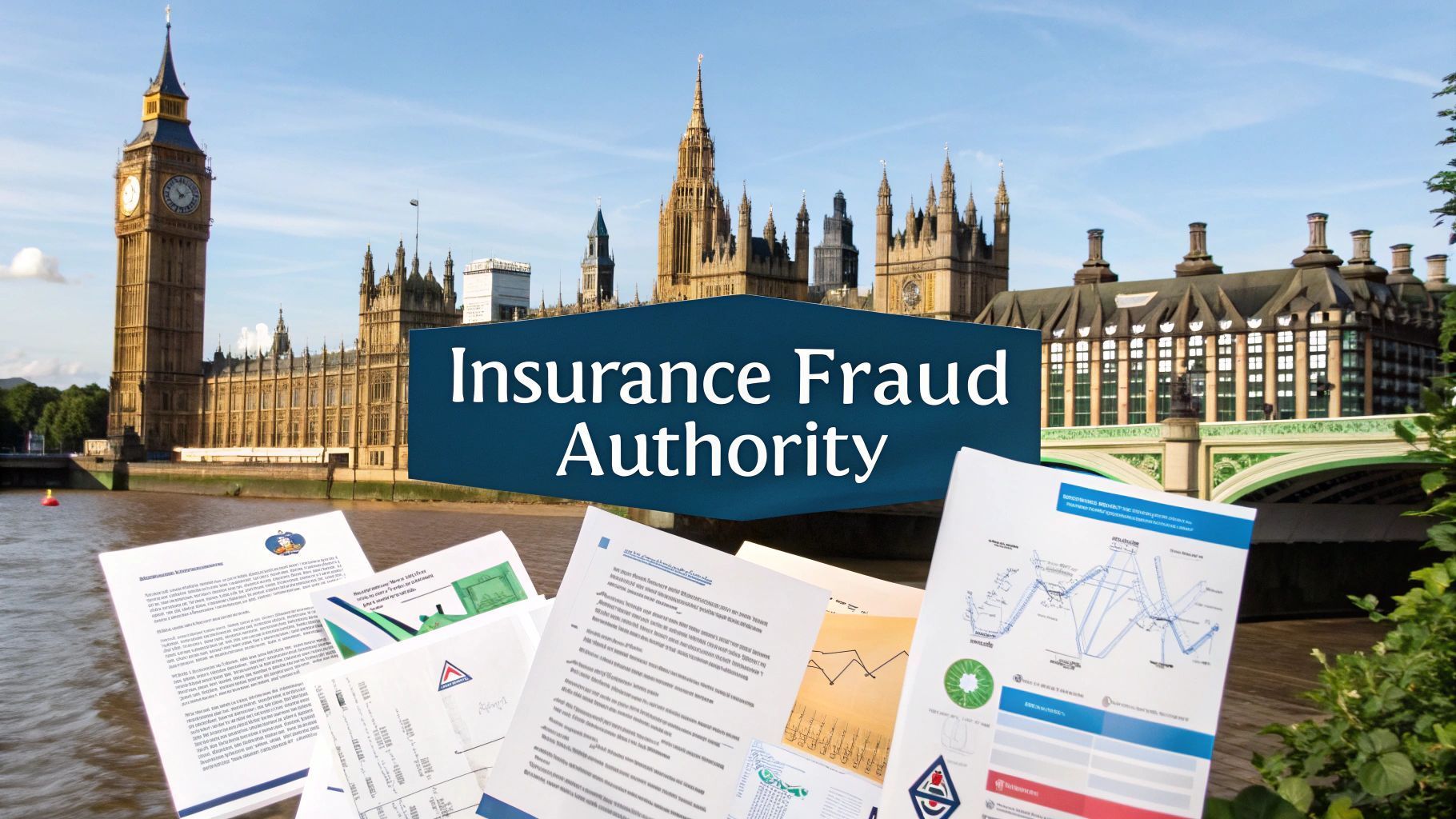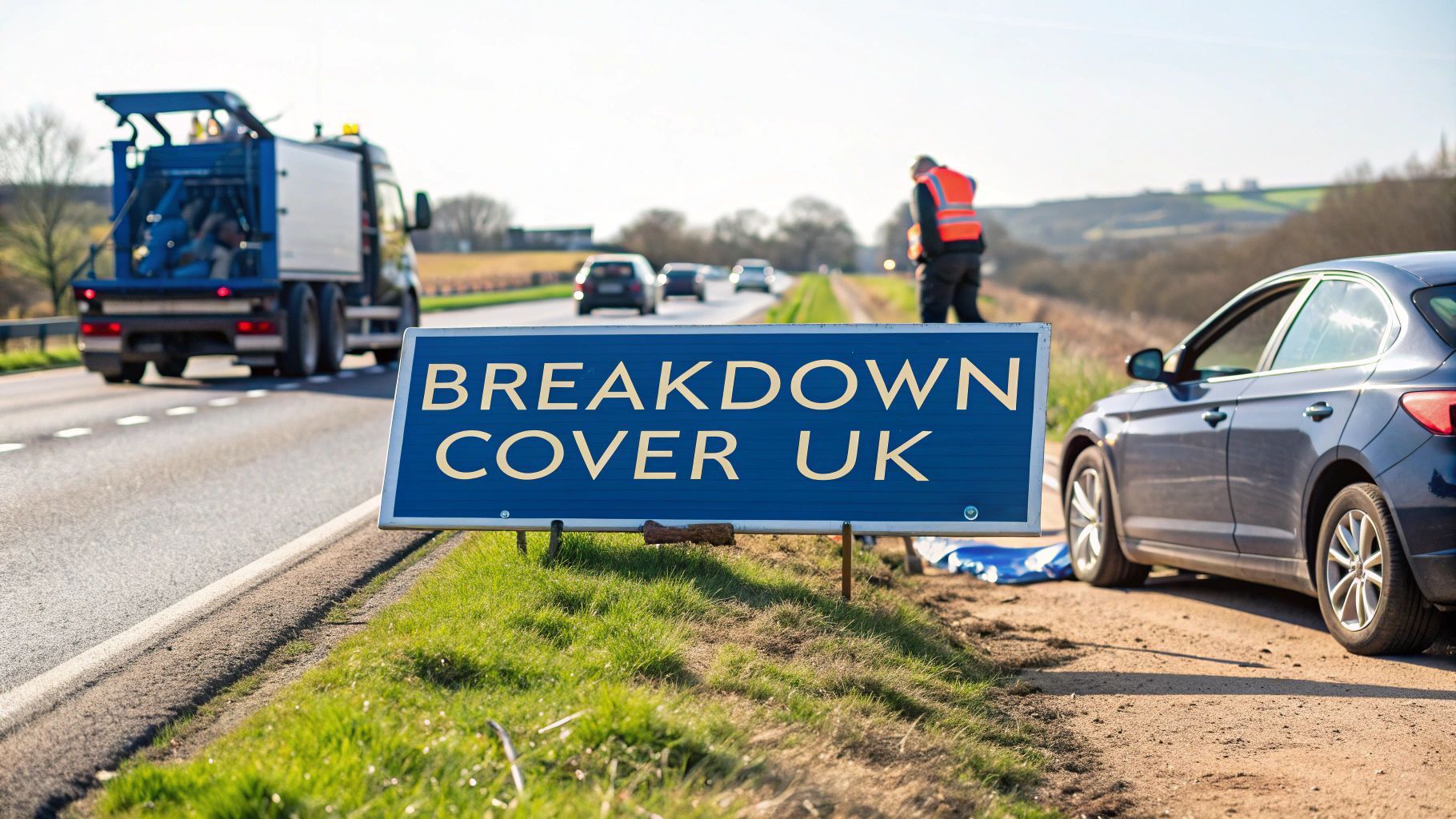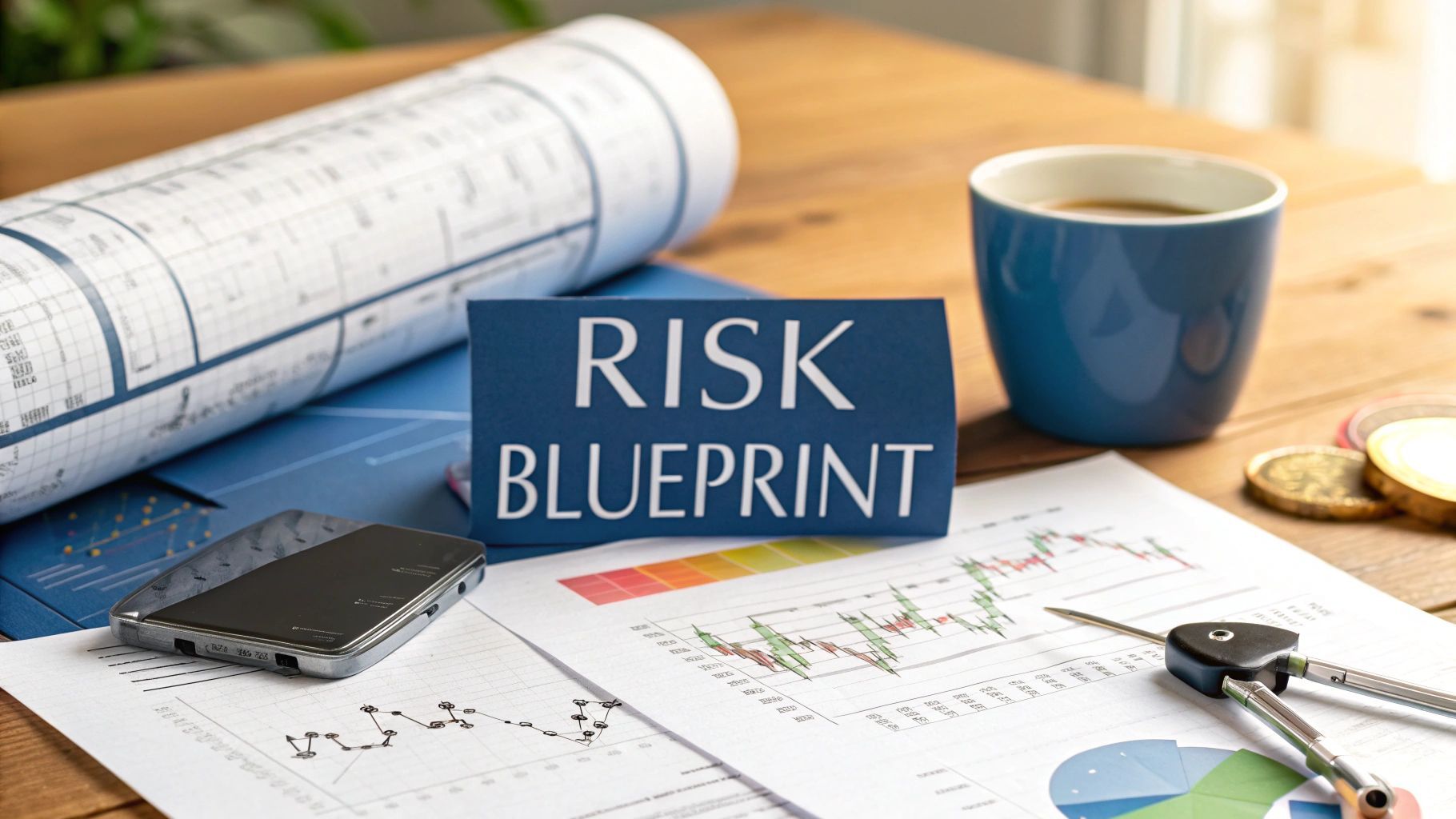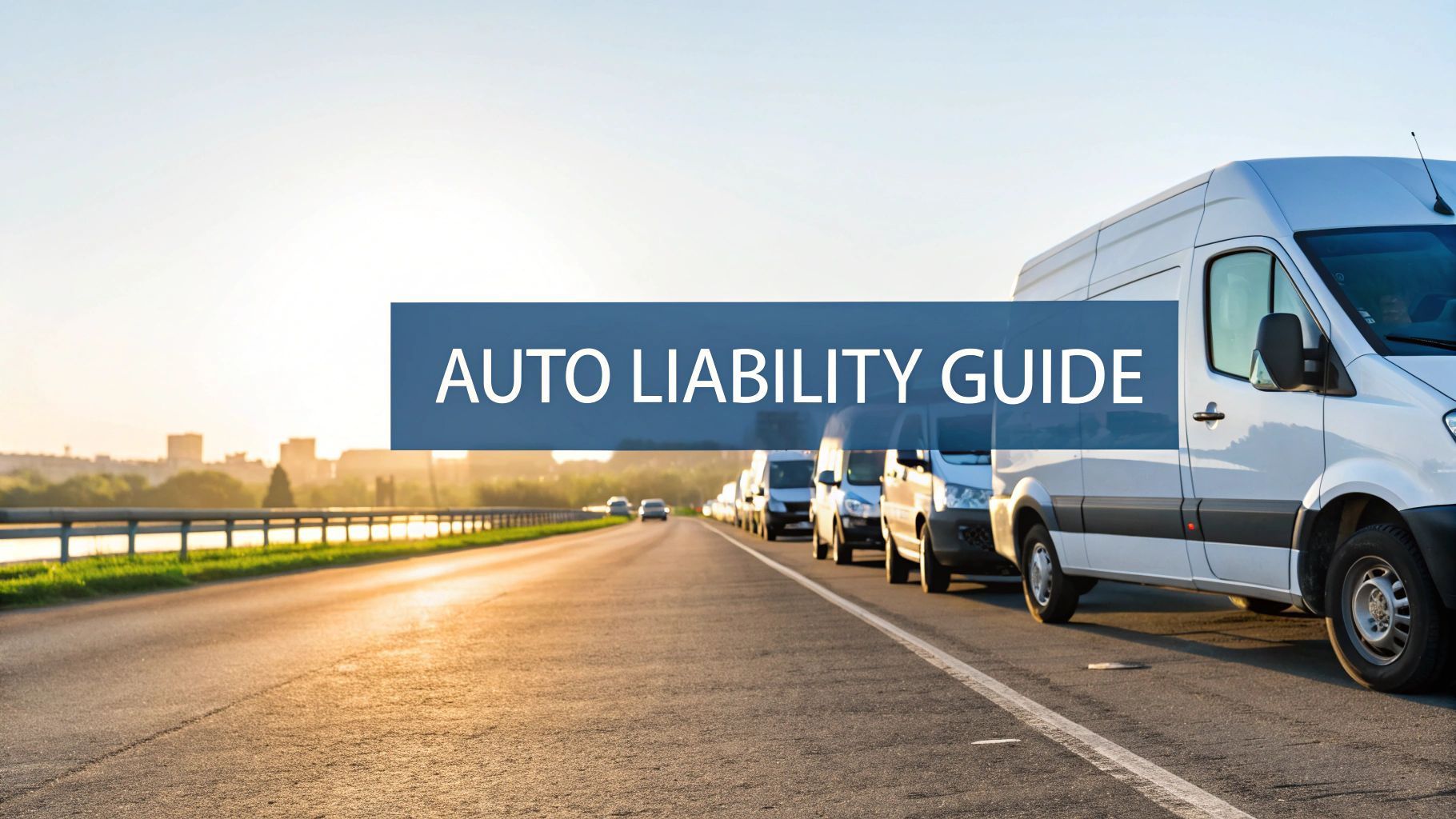How Do No Claims Bonuses Work: UK Guide
Think of a No Claims Bonus (NCB) as your insurer's way of saying "thanks" for being a safe driver. It's a loyalty reward, really. For every year you drive without making a claim, you earn a discount on the premium you'll pay the following year. It’s a simple, effective system designed to reward careful drivers.
Understanding the No Claims Bonus
A No Claims Bonus, sometimes called a No Claims Discount, is a fundamental part of motor insurance here in the UK. It's all about rewarding motorists for claim-free driving by chipping away at their annual premium. The longer you go without needing your insurer to pay out for an incident, the bigger that discount gets.
The whole thing works pretty simply. Once you complete a full 12-month policy without making what’s known as a 'fault' claim, you earn one year's NCB. This discount then stacks up for each year you stay claim-free.
The Financial Incentive for Safe Driving
At its heart, the NCB system is built on shared responsibility. It stands to reason that safer, more responsible drivers are less likely to be involved in accidents that lead to claims. This keeps costs down for the insurer and they pass a chunk of those savings back to you through the NCB discount. It's a powerful financial nudge to drive carefully, which is good for everyone on the road.
On the flip side, when fraudulent or inflated claims happen, they push up the overall cost pool for insurers. Those expenses inevitably get spread across all policyholders, which means higher base premiums for everyone. So keeping an honest claims history isn't just about protecting your own discount; it’s about helping to maintain a fairer, more affordable insurance market for every driver.
The integrity of the No Claims Bonus system is critical. It hinges on drivers being honest and providing provable evidence from previous insurers. Trying to fake this record isn’t just bending the rules—it’s insurance fraud and that comes with serious consequences.
So how much can you actually save? The table below gives you a general idea of how the discount typically builds up.
Typical No Claims Bonus Discount Progression
This table shows how your No Claims Bonus discount typically increases with each consecutive year of claim-free driving in the UK.
| Claim-Free Years | Average Discount Percentage |
|---|---|
| 1 Year | Around 30% |
| 2 Years | Around 40% |
| 3 Years | Around 50% |
| 4 Years | Around 60% |
| 5+ Years | 60% to 65% (often capped) |
As you can see, after just one year without a claim, drivers can often get a discount of around 30% . This percentage climbs steadily each year, usually maxing out at about 60% to 65% after you've built up five or more consecutive claim-free years. Of course, the specifics can vary and if you want to dig deeper, you can find expert insights on how to protect your discount once you've earned it.
How You Build Your No Claims Bonus Year by Year
So how does this all actually work in practice? The way your No Claims Bonus (NCB) grows is refreshingly simple. For every full 12-month insurance period you go through without making a claim (or at least, a claim where your insurer is left out of pocket), you earn another year on your bonus.
It’s a straightforward reward system. Drive safely, avoid incidents and you’ll see your premiums come down. It’s the most direct financial incentive insurers have to encourage responsible driving.
This infographic breaks down the basic cycle:
As you can see, getting through a whole year without a ‘fault’ claim is the ticket to climbing to the next discount level.
What Actually Counts as a Claim?
This is where things can get a bit confusing but it’s a crucial detail. Not every time you contact your insurer about an incident will automatically torpedo your NCB. The real question is who was at fault and whether your insurer had to pay out money that it couldn't get back from someone else.
Let’s say another driver bumps into you and their insurance company accepts full responsibility. They cover all the repair costs for your car. In this case, your bonus should be safe. This is a 'non-fault' claim . Because your insurer didn't lose any money, there's no reason to penalise you.
On the other hand, a 'fault' claim is any situation where your insurer has to cover the costs. This isn't just about accidents where you're clearly to blame. It also includes trickier scenarios like:
- You and another driver share the blame for an accident (a 'split liability' claim).
- Your car is stolen or vandalised and the person responsible is never found.
- Someone without insurance hits your car, leaving your insurer to pick up the tab.
In any of these cases, your insurer pays out and your hard-earned NCB will almost certainly take a hit. Typically, you’ll lose two years from your bonus for a single fault claim.
The Importance of Continuous Cover
Here's a major pitfall to watch out for: your NCB isn't permanent. While it’s a valuable asset, it comes with an expiry date if you step away from driving.
If you have a significant break from being insured on a policy in your own name—maybe you move abroad, sell your car or rely on a company vehicle—your NCB will eventually become invalid.
For most UK insurers, the grace period is two years . If you go without your own car insurance policy for more than 24 months, your accumulated discount will completely expire. You’ll be back at square one, starting from zero.
This 'two-year rule' is why it's vital to know the fine print. Letting your bonus lapse can mean a nasty shock when you decide to get back on the road, with your premiums suddenly shooting up. The system is built on having a recent, provable history; without one, insurers see you as a new, unknown quantity.
The Real Financial Impact of a No Claims Bonus

The true value of a No-Claims Bonus, or NCB, really hits home when you see the numbers. This is especially true for young drivers, who often face the steepest premiums on the market simply because they don't have a proven history of safe driving.
An NCB is your direct route to more affordable car insurance. It’s a tangible reward for your responsibility behind the wheel.
Building up your NCB is one of the most powerful long-term strategies for slashing your insurance costs. The financial gulf between starting with zero bonus and holding the maximum discount after five years can easily run into thousands of pounds. Best of all, this system is built on provable history, not just assumptions about risk.
The Stark Contrast for Young Drivers
The impact is most dramatic for newly qualified drivers. Insurers see them as a higher statistical risk and their policy prices reflect that. For a young driver, those first few years of claim-free driving are absolutely critical for getting these eye-watering costs under control.
For example, a 17-year-old just starting out could be looking at premiums as high as £2,877 . Why so much? Because they have no discount history to offset the risk in an insurer’s calculations. The average premium for drivers aged 17 to 24 is a hefty £834 a year, which shows just how big the financial burden can be.
This financial pressure is exactly why the NCB system is so important. It offers a clear, achievable reward for staying accident-free, turning a huge initial cost into something far more manageable over time.
The Hidden Cost of a Dishonest System
The entire NCB structure depends on one thing: an honest and provable claims history. When a driver falsifies their no-claims record or conveniently "forgets" to disclose an incident, it’s not just bending the rules—it’s insurance fraud. This kind of deception undermines the fairness of the system for everyone.
Insurance fraud is far from a victimless crime. It creates a ripple effect that hurts the whole industry and every honest driver in it.
- Increased Premiums for Everyone: When insurers have to pay out on fraudulent claims, they absorb those losses by raising the base premiums for all their honest policyholders.
- Higher Investigative Costs: Insurers are forced to invest time and money verifying claims and investigating suspected fraud. Naturally, these operational costs get passed on to customers.
- Eroding Trust: Widespread fraud damages the fundamental trust between insurers and the public, making the entire process more complicated and expensive for everyone involved.
The integrity of the no-claims bonus system is vital. Every fraudulent claim adds a small but real cost to the policies of honest drivers. Protecting your bonus legally is smart but trying to cheat the system harms the entire insurance pool.
Ultimately, keeping the system honest ensures that careful drivers get the rewards they’ve rightfully earned. This is why technologies that help verify claims honestly are becoming so crucial. By embracing new approaches, the industry can maintain the integrity of the system and ensure that discounts are earned fairly. To see how this works in practice, you can learn more about how pre-authentication can reduce claims costs and benefit everyone.
Is It Worth Paying to Protect Your No Claims Bonus?
After years of careful driving, you’ve probably built up a pretty substantial No Claims Bonus. The thought of losing that hard-earned discount after a single, minor bump can be a real worry. This is exactly where an optional add-on comes into play.
Most insurers offer what’s called a Protected No Claims Bonus (or PNCB). You can think of it as an insurance policy for your discount itself. For an extra fee on top of your premium, you get to make a certain number of fault claims without seeing your accumulated bonus wiped out.
Typically, this protection covers you for one or two fault claims over a few years. It’s designed to give long-standing, safe drivers some well-deserved peace of mind. While it does add to your upfront cost, protecting a big multi-year bonus could save you a small fortune if you end up having an accident.
Weighing Up the Cost and Benefit
Deciding whether to pay for protection is really a financial calculation. If you only have one or two years of NCB, the extra cost might not make much sense because the discount you’re protecting is still quite small.
But once you have four or five years of claim-free driving under your belt, that discount becomes seriously significant. In this scenario, the yearly cost of protection—which usually ranges from £30 to £100 —is often far less than the massive premium hike you’d face if you lost your bonus completely.
It’s critical to understand that protecting your bonus does not freeze your premium. It only safeguards the percentage discount. Your underlying base premium can, and likely will, still increase after you make a fault claim.
Understanding the Limitations of Protection
It’s essential to grasp how a protected bonus actually works in the real world. If you make a claim, your insurer will almost certainly see you as a higher risk. This means your base premium is likely to go up at renewal time, protection or not.
What the protection does is ensure your hard-earned 60% discount , for example, is applied to this new, higher premium instead of being slashed back to zero. It prevents a painful double-whammy but it doesn't stop your premium from rising altogether.
Before you decide, consider these key factors:
- Your Driving Record: If you have a long, spotless history of claim-free driving, you might feel confident enough to skip the extra cost.
- The Cost of Protection: How does the fee compare to the actual value of your discount? Do the maths.
- Your Risk Tolerance: How would a sudden, large increase in your premium affect your finances? Could you absorb that hit?
For many experienced drivers with a maximum bonus, that small yearly fee is a worthwhile investment for the security and peace of mind it provides.
Proving Your NCB and the Consequences of Fraud
When you switch car insurance providers, your new insurer isn’t just going to take your word for it when you tell them you have a hefty No Claims Bonus. The system is built on trust but it's always verified by proof. You'll need to hand over official documentation, which is usually your renewal letter from your last insurer or a dedicated proof of NCB letter they can send you.
This verification step is absolutely crucial for keeping the whole NCB system fair. It ensures the discounts people get are genuinely earned through a history of safe, claim-free driving. Trying to fake your NCB record or conveniently "forgetting" to mention previous claims isn't just bending the rules; it's a very serious misstep.
The High Cost of Dishonesty
Any attempt to provide false information or deliberately hide your claims history is considered insurance fraud or non-disclosure . The fallout can be severe and far more damaging than just losing out on a discount.
If an insurer uncovers that a policy was bought using misleading information, they have the right to take serious action. This could mean:
- Cancelling your policy on the spot, leaving you uninsured.
- Voiding the policy from the very beginning , as if it never existed.
- Refusing to pay out on a claim , forcing you to cover all the costs of an accident yourself.
These actions can be financially devastating. Worse still, having a policy cancelled for fraud gets recorded, making it incredibly difficult and eye-wateringly expensive to get insured by anyone else in the future. If you're ever in a tough spot with a claim, it's vital to understand why your insurance company might refuse to pay out and what you can do about it.
How Fraud Affects Every Driver
The problem of insurance fraud isn't just an individual issue; it ripples out and affects every single honest motorist in the UK. When insurers have to cover the costs of fraudulent claims or deal with the aftermath of accidents caused by uninsured drivers, where does that money come from? It gets passed on to all of us through higher premiums.
The reality is that dishonest claims and uninsured drivers create a hidden tax on everyone who follows the rules. The integrity of the NCB system is crucial because it helps reward good behaviour and keep the market fair. Any deception undermines this balance.
The scale of this problem is staggering. With an estimated one million vehicles being driven without insurance, the costs add up fast. The annual compensation for claims involving uninsured drivers now tops £500 million —a massive financial burden that ultimately gets spread across the premiums of every law-abiding driver. You can get more insight into how these market pressures shape insurance costs at consultancy.uk. This really drives home why proving your NCB honestly isn't just a personal responsibility but a collective one.
How Common Scenarios Affect Your No Claims Bonus

Life doesn’t stand still and your insurance situation will inevitably change along with it. Getting to grips with how these shifts affect your No Claims Bonus is crucial if you want to hang on to the discount you’ve worked so hard to build.
A common mistake is thinking your NCB is attached to your car. It isn't. It’s tied to you, the policyholder .
This is a really important distinction. Let's say you buy a second car; you can't just copy your existing NCB over to the new vehicle's policy. Your bonus can only be used on one policy at a time. While some insurers might offer a goodwill introductory discount on the second policy, you’ll have to start building a separate NCB for that car right from the beginning.
Common Events and Their Impact
So what about other situations? If you become a named driver on someone else's policy, you won't build your own NCB. The bonus always belongs to the main policyholder. That said, some insurers will recognise that experience and may offer you a discount if you later take out your own policy with them.
One of the most critical rules to remember is the two-year expiry. If you stop being the main policyholder on an insurance policy for more than 24 months —maybe you sold your car or moved abroad—your NCB will usually be wiped out completely. When you come back to driving, you're back at square one.
This is all about having a recent, provable and continuous claims-free history. Without it, insurers see you as a bigger risk. This strict rule also helps clamp down on fraud, stopping people from trying to use old or invalid NCB proofs. Staged accidents are a constant problem and you can learn more about how crash for cash scams harm honest drivers and drive up costs for everyone.
To make things clearer, let's break down how some of these common events typically affect your bonus.
Impact of Common Events on Your No Claims Bonus
This table outlines how different common events typically affect your No Claims Bonus status with UK insurers.
| Event | Typical Impact on NCB | Important Consideration |
|---|---|---|
| Buying a Second Car | Cannot be used on two policies at once; must build a new NCB for the second car. | Some insurers may offer a separate introductory discount on the second policy. |
| Becoming a Named Driver | You cannot earn your own NCB on someone else's policy. | May earn a discount from the same insurer when taking out your own policy later. |
| Taking a Driving Break | Expires if you are uninsured in your name for more than two years. | You will lose your entire discount and have to start building it again from scratch. |
As you can see, understanding these rules is key to protecting your hard-earned discount when your circumstances change.
Your Top No Claims Bonus Questions Answered
When you get down to the nitty-gritty of no-claims bonuses, a lot of practical questions pop up. Let’s tackle some of the most common ones to clear up how your bonus works in real-world situations.
Can I Use a No-Claims Bonus from a Company Car?
This is a classic 'it depends' situation but some insurers will say yes. To stand a chance, you'll need solid, provable evidence of a claim-free driving history from your employer.
What does that look like? Usually, it means getting an official letter on company-headed paper that confirms you were the sole driver of the vehicle. The letter must state the exact dates you drove the car and, crucially, detail any claims made during that time. Always call a new insurer before you buy a policy to check if they’ll recognise this experience.
What Happens to My NCB if My Car Is Stolen?
This is a tough one. Unfortunately, if you have to claim on your insurance for theft or vandalism, it's almost always treated as a ‘fault’ claim. Why? Because your insurer can't get its money back from another responsible party.
This means that making a claim for theft will almost certainly reduce your no-claims bonus. The only way around this is if you've paid extra to protect your NCB, which allows you to make a certain number of fault claims without it affecting your discount.
The entire system is built on two things: provability and cost recovery. If an insurer has to pay out and can't reclaim the money from someone else, it's considered a fault claim, regardless of who was actually to blame.
Does My No-Claims Bonus Expire?
Yes, it absolutely does and this is a critical rule to remember. For most UK insurers, your NCB will expire if you haven't held a car insurance policy in your own name for a continuous period of two years .
If you're planning to take a break from driving for longer than that, you'll most likely have to start building your NCB from scratch when you come back. It might seem harsh but this rule helps maintain the integrity of the system, ensuring discounts are based on a recent and provable driving history.
At Proova , we understand that proving what you own is the hardest part of any insurance claim. Our simple app allows you to create a secure digital inventory of your possessions, making the claims process faster, fairer and more transparent for everyone. Protect your assets and ensure a smooth claims experience by visiting https://www.proova.com.












